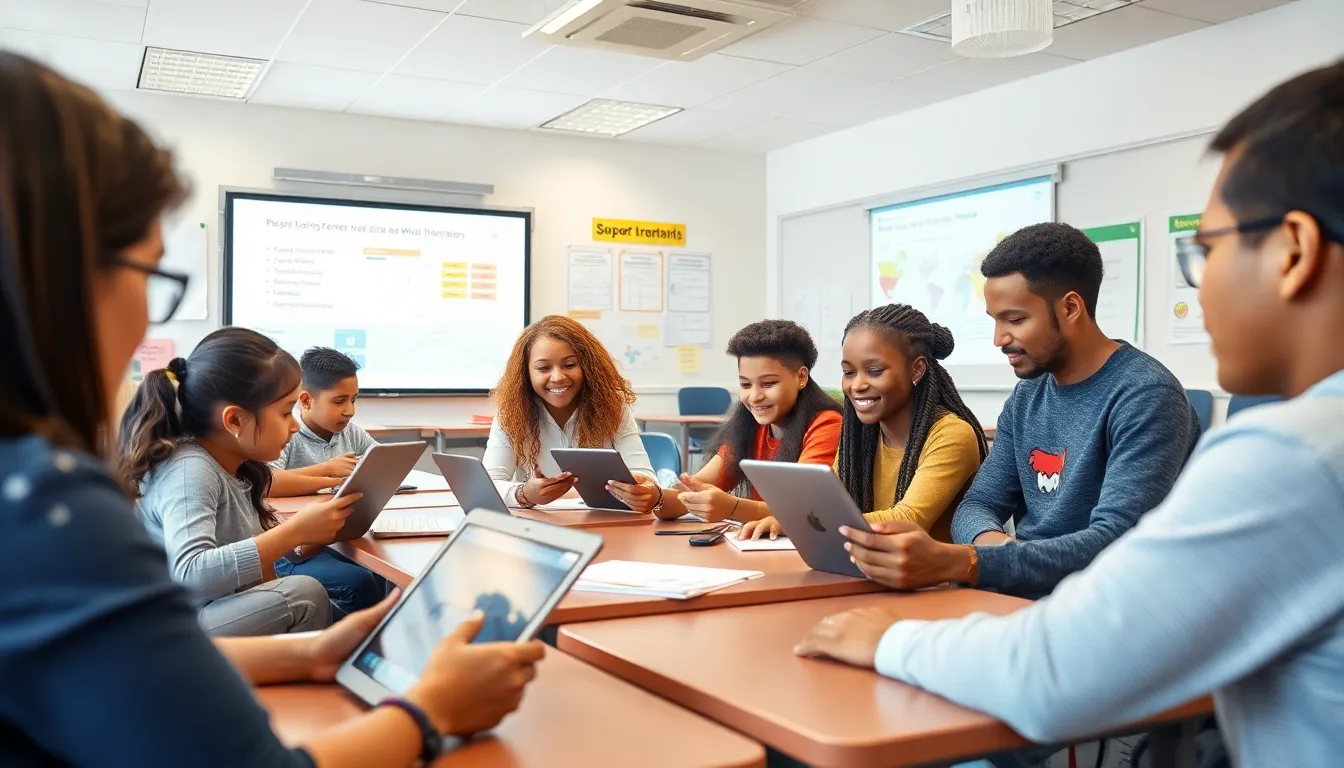In today’s fast-paced world, integrating technology in schools isn’t just a trend—it’s a necessity. Imagine a classroom where students are as engaged in their lessons as they are in their favorite video games. With the right tech tools, learning can transform from mundane to magical, making even the toughest subjects feel like a breeze.
But let’s face it—implementing technology isn’t just about slapping a few tablets on desks and calling it a day. It requires thoughtful planning, training, and a sprinkle of creativity. Schools that embrace this digital revolution can foster collaboration, spark innovation, and prepare students for a future that’s more tech-savvy than ever. So, buckle up as we explore the ins and outs of school technology integration and why it’s the key to unlocking a brighter educational experience for everyone involved.
Table of Contents
ToggleOverview of School Technology Integration
School technology integration involves embedding digital tools into the educational environment. Educators leverage software and hardware to create dynamic learning experiences. This process encourages student participation and fosters collaboration among peers.
Various tech resources enhance lesson delivery. Interactive whiteboards, for instance, allow teachers to present materials in engaging ways. Tablets and laptops provide students access to online resources and educational applications that support personalized learning.
Implementation requires strategic planning. Schools must assess their specific needs and choose suitable technologies. Training staff ensures they’re equipped to use these tools effectively. Furthermore, fostering a culture of creativity encourages innovative teaching methods.
Evaluating the impact of technology is essential. Schools should gather data on student performance and engagement to measure success. Regular feedback from students and educators helps refine the integration process.
Investing in infrastructure supports long-term sustainability. Reliable internet access and proper tech maintenance significantly influence the effectiveness of integration efforts. A well-planned approach leads to improved educational outcomes and prepares students for a technology-centric world.
Benefits of Technology in Education

Technology integration in education leads to numerous advantages, reshaping learning environments for students and educators alike.
Enhanced Learning Experiences
Technology facilitates diverse learning modalities, catering to various student needs. Interactive tools, such as simulations and educational software, allow deeper exploration of subjects. These resources engage students actively, making complex concepts easier to grasp. Visual aids, like videos and infographics, support understanding and retention of information. They also provide immediate feedback, helping students identify areas for improvement instantly. Enhanced accessibility features in technology ensure all students, including those with disabilities, can participate fully.
Improved Student Engagement
Engagement levels rise significantly when technology becomes part of the classroom. Gamification of lessons incorporates game-like elements, motivating students to participate. Collaborative tools enable group work and foster teamwork, creating a sense of community. Real-time data analytics give educators insights into student performance, allowing for timely interventions. Students often find tech-enhanced lessons more enjoyable and relevant to their lives. Personalized learning paths ensure that students can progress at their own pace, keeping motivation high.
Challenges in Technology Integration
Integrating technology in schools presents several challenges that need addressing for successful implementation.
Budget Constraints
Budget constraints often limit schools’ ability to invest in necessary technology. Many districts face tight financial situations, preventing them from acquiring updated devices or software. Insufficient funding can also restrict ongoing maintenance costs, essential for keeping tech resources functional. Schools must prioritize spending to cover both initial purchases and long-term support. Exploring grants and partnerships with tech companies can alleviate some financial pressure. Additionally, cost-sharing initiatives among schools can foster collaborative resource usage.
Teacher Training and Support
Teacher training and support play a critical role in effective technology integration. Many educators may lack adequate training to utilize new tools fully. Providing ongoing professional development ensures teachers feel comfortable and competent with technology. Schools can implement mentoring programs to foster peer-to-peer learning, enhancing instructional practices. Regular workshops and training sessions help keep teachers updated on emerging technologies. Moreover, schools should create support networks, allowing educators to share strategies and resources effectively.
Best Practices for Effective Integration
Integrating technology in education requires strategic approaches to enhance learning experiences. Various tools foster engagement and improve educational outcomes.
Collaborative Learning Tools
Collaborative learning tools promote teamwork among students. Platforms like Google Workspace and Microsoft Teams allow for real-time collaboration. Students can work together on projects, share resources, and communicate effectively. Such tools cultivate critical thinking and problem-solving skills. Educators can facilitate discussions and collaborative activities through these platforms. Many teachers use shared documents and cloud storage to streamline group assignments. By leveraging these tools, schools can create an interactive learning environment.
Assessment and Feedback Technologies
Assessment and feedback technologies streamline the evaluation process. Tools such as formative assessment apps provide immediate feedback to students. Teachers can tailor instruction by analyzing real-time data. Using platforms like Kahoot! and Quizizz engages students through interactive quizzes. Quick assessments enhance understanding and retention of material. Educators also benefit from data analytics that highlight individual student progress. These insights enable timely interventions for those who require additional support. Integrating assessment technologies ensures ongoing communication between educators and students, promoting a continuous learning cycle.
Future Trends in School Technology Integration
Emerging technologies are shaping the future of school technology integration. Artificial intelligence (AI) enhances personalized learning paths, adapting materials to fit individual student needs. Virtual reality (VR) offers immersive experiences that transform traditional classroom lessons into interactive explorations, allowing students to engage more deeply with the content.
Data analytics plays a crucial role in assessing student performance, pinpointing areas for improvement. Integrating AI-driven tools helps educators understand student engagement in real time, fostering timely and targeted interventions. Furthermore, the adoption of cloud-based platforms streamlines access to resources, enabling collaboration from any location, which enhances teamwork among students.
Innovative approaches, like gamification, motivate students, making learning fun and competitive. Implementing game-based learning encourages participation and sustains interest in subjects that students might typically find challenging. In addition, mobile technology is becoming increasingly prevalent in classrooms, providing students with learning opportunities beyond the school environment.
The shift toward blended learning models supports flexible teaching approaches. Combining face-to-face instruction with online activities allows for differentiated learning experiences that cater to diverse learning styles. As schools continue embracing these technologies, professional development for educators remains essential. Training programs must evolve to address new tools effectively, ensuring teachers feel confident in their abilities to integrate technology seamlessly.
Overall, future trends indicate a strong movement towards an integrated and tech-savvy educational landscape. Collaborative technologies and innovative teaching methods are reshaping how students learn and interact, positioning them better for future challenges. Continuous adaptation and strategic investments in technology resources will drive these positive changes in school environments.
Conclusion
Embracing technology in schools is more than a trend; it’s a necessity for fostering an engaging and effective learning environment. By strategically integrating digital tools and providing adequate training for educators, schools can create dynamic experiences that cater to diverse learning needs. The benefits are clear—enhanced student engagement, personalized learning, and improved educational outcomes.
As technology continues to evolve, schools must remain adaptable and proactive in their approach. Investing in infrastructure and ongoing professional development is crucial for sustaining these advancements. The future of education lies in the successful integration of technology, paving the way for innovative teaching methods and better preparing students for a rapidly changing world.



